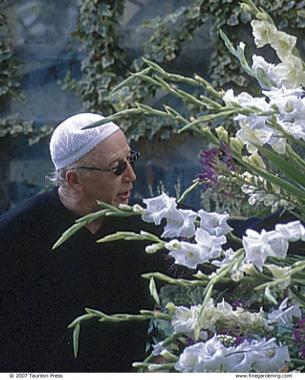
It would not be overstatement to say that Ryan Gainey is often considered a legend in the horticultural world. Gardens he’s designed throughout the United States and in France have received much recognition, and he has mentored many of Atlanta’s garden designers. He has also displayed his sense of style and design by way of the imaginative settings he’s created for fund-raising events in Atlanta as well as in three horticulturally themed shops he has owned over the years.
I caught up with Ryan at his home and garden, in Decatur, Georgia. His life appeared to be a whirlwind of activity, but his garden felt serene and welcoming. As we meandered around the garden, and then during an errand to The Home Depot in search of materials for a project, we talked about his approach to design, especially how he uses patterns to create structure within a garden.
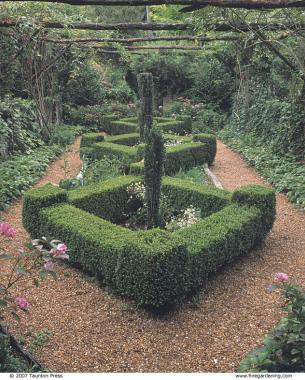
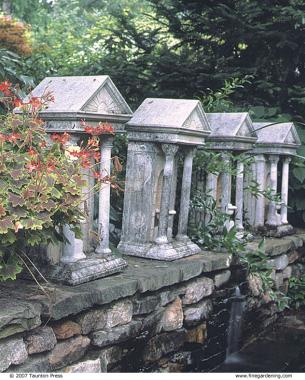
FG: Although your garden has an informal air, it has many formal elements.
RG: Everything in the world has to be formed for it to be free. Many people think that they can go out and put a bunch of flowers in the yard and it becomes a cottage garden. Well, that’s just a mess. There’s no form; there’s no definition.
FG: So there’s more to it than that?
RG: Yes, gardens need to be defined. One of the ways I like to create definition is with some sort of pattern. Patterns can be created with physical structures, like arbors, fences, gates, pathways, and other hardscaping. They can also be formed by repeating objects or by manipulating plants.
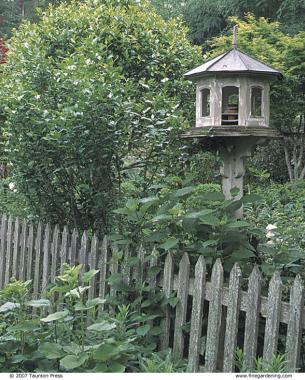
FG: What functions do these patterns serve?
RG: A garden needs patterns to hold it together. Some types of patterns rely on piecing together little bits of something. For example, mosaics are one of the oldest art forms on earth. It’s the same as patchwork, stonework, or a jigsaw puzzle. We can also do this by pulling together various aspects of our lives, of our heritage and experiences, and weaving them into our gardens.
FG: Did you approach the making of your garden as a type of patchwork?
RG: Yes, in the sense that the goal was to take many facets of something and blend them together as a whole, so that no one single element stands out. My garden is a total evolution of all my life experiences—where I’ve been, what I’ve seen and learned about plants, people, gardening, history, and all the romantic nuances that you could ever conjure up. The only reason I can give you a plan of my garden is that it’s now done. I’ve also used things that were on this property, like concrete pavers and terra-cotta pots left over from the previous owners, who had built several greenhouses. I’ve used both the pots and the pavers to create patterns within this garden. They have a visual effect, and they also are like old cloth being recycled into a quilt.
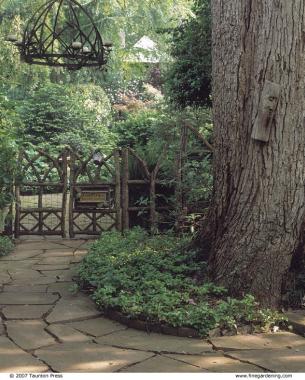
FG: When did you first start playing with patterns?
RG: As a child, I used to sit and watch my neighbor make patchwork quilts with recycled cloth, and I would also put together puzzles with her. Later, I got to help my mother decorate cakes with an aluminum press. I think that all these activities had a profound influence on my interest in piecing things together to make something beautiful.
FG: You also use several
geometric shapes in the layout of your garden.
RG: Everything in the world is composed of basically the same shapes—spheres, cylinders, diamonds, and squares. One of the rooms of my garden is laid out in quadrants, which reflects an old tradition in garden making. These quadrants represent the four chambers of the human heart. The circular shape in the center of one of my garden rooms is reinforced by cast-iron edging stones that have a rounded scallop shape. Concrete pavers radiate from the circle bed to complete the circular pattern. I’ve also repeated the form of a diamond as the underlying structure in another garden room.
FG: How does manipulating the shapes of plants help to define a garden?
RG: You can take plants and clip them into geometric forms to create the effect of a pattern or a shape, then repeat that shape. You can create a boxwood ball or you can make flat-top squares out of boxwoods. If you like whimsical topiaries, you can create a poodle, or a rabbit, or a chicken on a stick. Do whatever you want to do, but it’s all clipping. That’s the part of gardening that people misunderstand: Manipulation is what gives us structure. You shape, you clip, you peg, you bend, whatever. I hear people say, “I don’t like that; that’s horrible.” Well, you know what you get when you take the formal structure out of your body? You get a jellyfish, and who wants to be a jellyfish?
FG: Is it difficult to bring many different elements into a garden?
RG: It’s all about taking as much as you can and getting it in one place, but keeping it simple and making it beautiful. You can embrace all those nuances of the past—pattern, manipulating plants, stonework, temples, follies, ruins, vistas, views, nature, and water. I think a complete garden is composed of all these elements, and you can have that on a terrace. You can grow plants in pots, you can have patterned stonework, you can have a clipped hedge, you can cut holes in the hedge, you can create a wall for enclosure, then cut a hole in it to have a view. The key is to understand the complexity of simplicity.
FG: How do you do that?
RG: By saying “No, no, no, no, no, no, no. You can’t have that, you can’t have that, but this you can have.” You have to make hard decisions. Sit down and figure out what you want. Train yourself to really see things, to feel, to become intimate with the whole experience of something. In other words, I look at a flowering plant and I think, “I want one of those,” then I look at it more deeply. I find out how it grows, how big it gets, whether I can shape it or whatever, and then I think about whether I can truly make a place for it in my garden.
FG: How would you encourage people to expand their sense of possibility?
RG: I think traveling to different places is essential. Go look at botanical gardens, arboretums, private gardens, public gardens. And when you’re there, look, look, look, and then go back and look again. Try to figure out what you want that you would be willing to implement and maintain. Try to see what really stirs the passion that is essential to making and tending a garden.
Patterns within a pattern
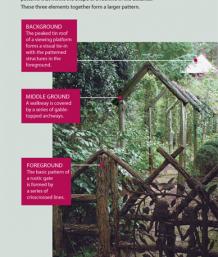
Ryan Gainey reinforces the impact of patterns by repeating them, with variations, throughout his garden. In this section, a gate and a series of archways are examples of two similar patterns that mimic the shape of a roofline in the distance. These three elements together form a larger pattern.

















Comments
Log in or create an account to post a comment.
Sign up Log in